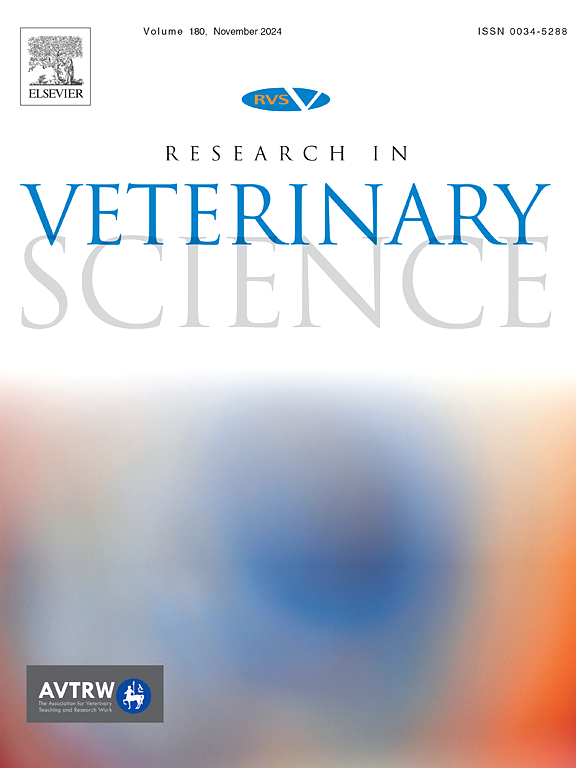Loss of viability and impairment of the cell cycle by combining metabolic modulators in canine and feline melanoma cells
IF 2.2
3区 农林科学
Q1 VETERINARY SCIENCES
引用次数: 0
Abstract
Despite encouraging advances during the last decade, clinical management of malignant human, canine and feline melanoma continues to be a challenge. Thus, new therapeutic development is required. One of the hallmarks of cancer is metabolic rearrangement, including increased glucose metabolism. This metabolic alteration seems to be involved not only in cell proliferation but also in drug resistance, thus offering potential therapeutic targets. The aim of the present work was to investigate the in vitro effects of a combination of metformin (MET, an antidiabetic drug and OXPHOS inhibitor), 2-deoxyglucose (2DG, an HK inhibitor) and 6-aminonicotinamide (6AN, a G6PDH inhibitor) on two melanoma cell lines, Sc (canine) and Dc (feline) derived from spontaneous tumors. We found that both 2DG and MET treatment significantly decreased the cell viability of both cell lines (p < 0.05) in a concentration-dependent manner, whereas 6AN as monotherapy only significantly affected Sc. In addition, the effect of MET was significantly potentiated (p < 0.05) by the combination with both 2DG and 6AN in both cell lines. MET/2DG and MET/6AN significantly affected the cell cycle and increased the percentage of the subG0 population. These results support further studies to investigate the potential use of these metabolic drugs in a veterinary clinical setting.
犬和猫黑色素瘤细胞中代谢调节剂的结合导致细胞周期丧失活力和损伤
尽管在过去十年中取得了令人鼓舞的进展,但人类、犬类和猫科恶性黑色素瘤的临床管理仍然是一个挑战。因此,需要开发新的治疗方法。癌症的特征之一是代谢重排,包括葡萄糖代谢增加。这种代谢改变似乎不仅与细胞增殖有关,而且与耐药有关,因此提供了潜在的治疗靶点。本研究的目的是研究二甲双胍(MET,一种抗糖尿病药物和OXPHOS抑制剂)、2-脱氧葡萄糖(2DG,一种HK抑制剂)和6-氨基烟碱酰胺(6AN,一种G6PDH抑制剂)联合使用对两种自发肿瘤黑色素瘤细胞系Sc(犬)和Dc(猫)的体外影响。我们发现2DG和MET处理均显著降低了两种细胞系的细胞活力(p <;0.05)呈浓度依赖性,而6AN单药治疗仅显著影响Sc。此外,MET的作用显著增强(p <;0.05),与2DG和6AN结合。MET/2DG和MET/6AN显著影响细胞周期,增加亚g0群体的百分比。这些结果支持进一步研究这些代谢药物在兽医临床环境中的潜在用途。
本文章由计算机程序翻译,如有差异,请以英文原文为准。
求助全文
约1分钟内获得全文
求助全文
来源期刊

Research in veterinary science
农林科学-兽医学
CiteScore
4.40
自引率
4.20%
发文量
312
审稿时长
75 days
期刊介绍:
Research in Veterinary Science is an International multi-disciplinary journal publishing original articles, reviews and short communications of a high scientific and ethical standard in all aspects of veterinary and biomedical research.
The primary aim of the journal is to inform veterinary and biomedical scientists of significant advances in veterinary and related research through prompt publication and dissemination. Secondly, the journal aims to provide a general multi-disciplinary forum for discussion and debate of news and issues concerning veterinary science. Thirdly, to promote the dissemination of knowledge to a broader range of professions, globally.
High quality papers on all species of animals are considered, particularly those considered to be of high scientific importance and originality, and with interdisciplinary interest. The journal encourages papers providing results that have clear implications for understanding disease pathogenesis and for the development of control measures or treatments, as well as those dealing with a comparative biomedical approach, which represents a substantial improvement to animal and human health.
Studies without a robust scientific hypothesis or that are preliminary, or of weak originality, as well as negative results, are not appropriate for the journal. Furthermore, observational approaches, case studies or field reports lacking an advancement in general knowledge do not fall within the scope of the journal.
 求助内容:
求助内容: 应助结果提醒方式:
应助结果提醒方式:


